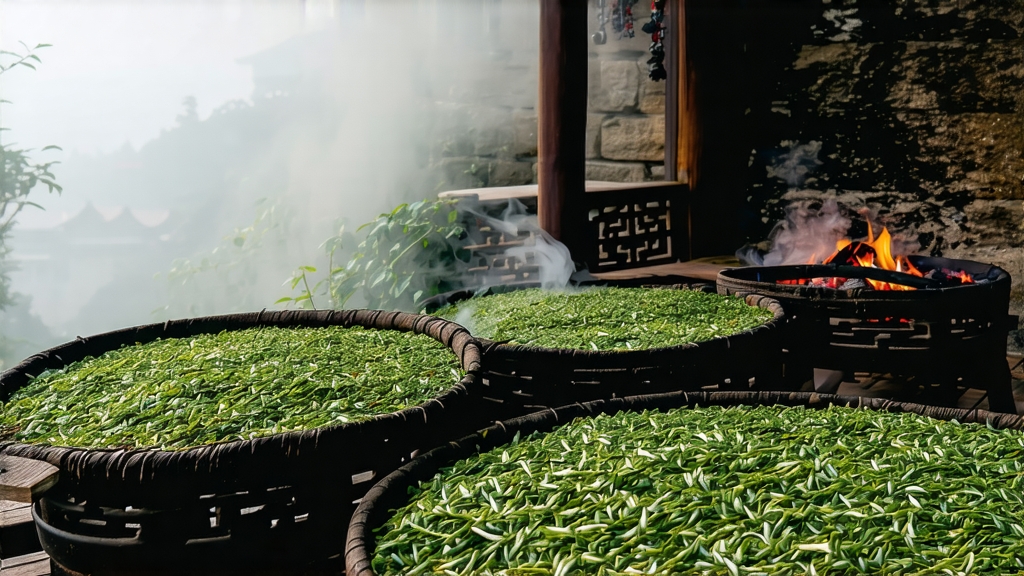
When European tea drinkers first encountered the dark, twisted leaves that produced a liquor as crimson as claret and a scent reminiscent of a campfire in a pine forest, they were tasting Lapsang Souchong—what Chinese archives call Zheng Shan Xiao Zhong. Today the name is slapped on everything from whisky essences to lip balm, yet the authentic leaf remains one of China’s most misunderstood treasures. To know it is to step into the cradle of black-tea history, where the very concept of fully oxidised leaf was born in the frost-laced highlands of Fujian’s Wuyi range four centuries ago.
History: from imperial ban to London drawing rooms
The Wuyi massif, a UNESCO dual heritage of biodiversity and culture, has produced tea since the Song dynasty, but all of it was green or oolong until the late Ming. Folklore claims that in 1646 a passing Qing army commandeered a village drying shed; anxious farmers, eager to move the leaf before it spoiled, hastened oxidation over open pine fires and shipped the result to the Dutch at Xiamen. The foreigners adored the smoky edge, and by 1669 the British East India Company listed “Bohea Souchong” at 28 shillings a pound—more than a skilled craftsman earned in a month. The Kangxi Emperor later lifted an imperial ban on coastal trade, and caravans of mules carried bamboo-leaf-wrapped chests over the Meiling pass to the Pearl River, then past Malacca to London coffeehouses where Samuel Pepys first scribbled “tcha” in his diary. Thus Lapsang Souchong became the prototype for every subsequent black tea, its very name a linguistic fossil: “Lapsang” from the Fuzhou dialect lao san—“pine mountain”—and “Souchong” referring to the fourth or fifth leaf that pluckers once deemed too coarse for green tea but perfect for smoke.
Terroir: why Wuyi’s microclimate cannot be cloned
Authentic Zheng Shan Xiao Zhong is circumscribed by a 600 km² national-protection zone centered on Tongmu Guan, a misty notch where the Huangshan and Wuyi ranges collide. At 1,200 m, diurnal swings of 15 °C slow oxidation, while quartz-rich soils drain monsoon rains within minutes. Indigenous insect species nibble leaf edges, triggering a burst of monoterpenes that later marry with pine resin. Attempts to replicate the process in India or Kenya collapse into acrid tar because the same leaves, once removed from this microbial terroir, lack the precursor sugars that soften smoke into sweet camphor.
Two styles: smoke and unsmoked
Purists recognise two siblings. Traditional Song Zhong (pine-smoked) is withered over embers of local Masson pine and Chinese red pine whose resin is first cured for three years; firing lasts eight hours at 80 °C, then another six at 60 °C, during which the leaf absorbs guaiacol and syringol molecules that later read as smoked apricot. Modern Wu Xiong (unsmoked) is withered in heated bamboo rooms and finished over charcoal; it tastes of longan, honey and mineral slate, proving that the cultivar itself carries innate fruitiness. Both qualify as Zheng Shan Xiao Zhong only if picked before Grain Rain from the small-leaf Xingcun or Cai Cha cultivars, and only if processed within the protected gorge.
Craft: the eight stages that turn leaf into memory
- Pluck: one tender bud plus two leaves, 5 a.m. mist still on them.
- Wither: 18 °C on pine-wood slatted racks, 60 % humidity, 8–10 hours until leaf loses 60 % moisture and emits a baked-peach aroma.
- Rolling: 55 minutes on a 70 cm bamboo drum, pressure rising from 2 kg to 20 kg to rupture cells without shredding.
- Oxidation: leaf piled 8 cm deep in pine-wood troughs at 24 °C, 85 % humidity; turned every 30 minutes for 2.5 hours until copper edges reach 90 % oxidation.
- Pan-firing: 220 °C for 3 minutes to arrest enzymes, locking in a mahogany core.
- Rolling again: tighter twists, 40 minutes, releasing sticky sap that will caramelise during smoking.